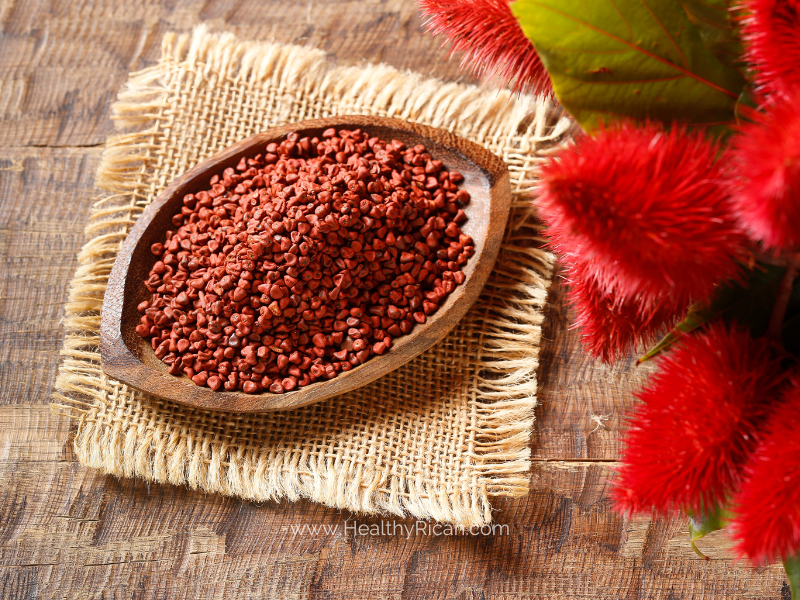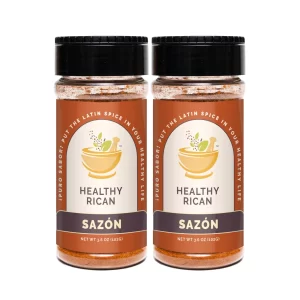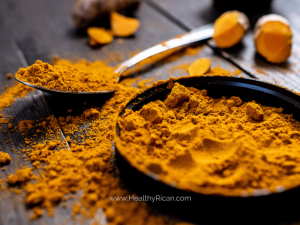What is Sazón?
A delicious spice blend called sazón is often used in recipes from the Caribbean and Latin America. Annatto, which lends a lovely color, is one of the spices used in the mixture along with cumin, coriander, and garlic powder. Sometimes, it includes salt, pepper, and spices from the area too. Its versatility enhances the flavor of a variety of foods such as rice, beans, stews, and meats. It’s quite practical.
Sazón Is Key in Latin Cooking for a Few Reasons:
Sazón plays a crucial role in Latin cuisine for several reasons:
- Boosts Flavor: Sazón adds a rich and complex taste to food.
- Cultural Touch: In many Latin American and Caribbean homes, sazón is a must-have. It has a significant role in their traditional recipes and is a part of their culinary culture and history.
- Makes Cooking Easier: Sazón is a handy mix of several spices, which makes cooking simpler. Instead of adding lots of different spices one by one, you just use sazón.
- Adds Color: Thanks to annatto, sazón gives food a bright, appealing look. A dish’s appearance is just as important as its taste in many cuisines, and sazón helps with that.
- Great for Many Dishes: Sazón is really versatile. Rice, beans, soups, stews, meats, and marinades are just a few of the dishes that call for it. It is the favored spice in a wide variety of recipes.
In general, sazón is about adding convenience, color, and a bit of cultural history to Latin American and Caribbean cooking—it’s about more than just flavor.
Why Choose Natural Sazón?

Opting for natural sazón or making your own blend using natural ingredients offers several advantages:
Healthier Option
Natural sazón typically avoids additives, artificial colors, preservatives, and excess sodium often found in commercial seasoning blends. Using natural spices allows you to control what goes into your food, promoting a healthier diet.
Customization
Making your own sazón blend gives you the freedom to adjust the quantities of individual spices based on your preferences and dietary needs. You can also try out various herbs and spices to craft distinctive tastes.
Freshness
Creating your sazón blend from scratch ensures the freshness of the spices, providing better flavor and aroma compared to pre-packaged options that might have been sitting on shelves for extended periods.
Reduced Sodium
Many commercial sazón mixes contain high levels of sodium. Making your own blend allows you to regulate the amount of salt or even omit it entirely, which is beneficial for those on low-sodium diets. Check out the health benefits of a low-sodium diet below.
Authenticity
If you’re exploring traditional or authentic recipes, using natural sazón allows you to stay true to the original flavors and methods used in specific cuisines.
Ingredient Transparency
When you prepare your sazón at home, you know precisely what ingredients are included, avoiding hidden or unspecified components that might be present in store-bought blends.
Creating your natural sazón blend can be simple and rewarding, offering both health benefits and the satisfaction of preparing your seasoning from scratch. It lets you take control of your ingredients while exploring diverse flavors in your cooking.
Ingredients Not Needed in Sazón:
In a traditional sazón blend, certain ingredients might not be necessary or might be considered non-traditional. Some of these could include:
- Artificial Additives: Authentic sazón typically doesn’t include artificial colors, flavors, or preservatives. Using natural ingredients is more aligned with traditional preparations.
- High Sodium Additives: Some commercially produced sazón mixes might contain excessive salt or MSG (monosodium glutamate). For a more health-conscious or homemade version, these can be omitted or reduced.
- Fillers or Extenders: Some commercial blends might include fillers or extenders to increase bulk or shelf life. These might not be necessary in a homemade sazón blend.
- Unspecified Spices or Additives: Homemade sazón allows you to control the ingredients. Omitting unspecified spices or additives gives you transparency about what’s in your seasoning mix.
Remember, sazón is a versatile blend, and different regions or households might have variations in their recipes. Making your own sazón blend gives you the flexibility to adjust the ingredients according to your personal preferences and dietary needs, all while preserving the flavors you cherish.
7 All-Natural Sazón Seasoning Alternatives:
- Annatto seeds in oil (aceite de achiote) – Check out our recipe below!
- Ground annatto (achiote molido)
- Saffron (azafrán)
- Turmeric (curcuma) – check out the health benefits of turmeric below.
- Paprika
- Blend of annatto & turmeric
- Blend of paprika & turmeric
Bonus Alternative to commercial Sazón:
 Try our Healthy Rican Sazón! Our all natural sazón is made with all natural ingredients; like annatto, turmeric, garlic, coriander and a hint of cumin. It is completely Salt-Free, as well as free of any additives, preservatives and artificial ingredients.
Try our Healthy Rican Sazón! Our all natural sazón is made with all natural ingredients; like annatto, turmeric, garlic, coriander and a hint of cumin. It is completely Salt-Free, as well as free of any additives, preservatives and artificial ingredients.
How to Make Sazón Seasoning with no salt or MSG:
Create your own blend by combining ground cumin, ground coriander, garlic powder, dried oregano, and annatto powder. Mix the ingredients thoroughly until well combined. Ensure the annatto powder is evenly distributed throughout the blend. Experiment with the ingredients and flavors until you achieve a blend you like.
A homemade sazón seasoning can be used as a flavor enhancer in various Puerto Rican dishes without adding extra salt or MSG. Modify the amounts to match your taste preferences, or try adding extra spices such as paprika, turmeric, or onion powder for a unique personal touch.
Aceite de Achiote” (Oil of Annatto)
Materials
- 1/4 cup annatto seeds try our infused with garlic & peppercorns for extra flavor
- 1 cup oil of choice For this, you can use any type of oil you cook with. Traditionally, our grandmothers used lard as the oil/fat of choice. Healthier options include; avocado oil and refined coconut oil.
Instructions
- Add oil and annatto seeds into a small pot.
- Heat the oil on low until it boils, and let it boil for 5 minutes, or until it achieves the desired color.
- Do not boil for more than 10 minutes to avoid the burning of the seeds.
- Allow to cool and strain the oil into a glass jar.
- If desired, you can save the annatto seeds for another time as you can use the same seeds twice.
How to Use “Aceite de Achiote”
You can use oil of annatto in place of plain oil when cooking rice, beans, stews, and to marinate meats. In Puerto Rican cuisine, oil of annatto is used to stir fry the sofrito used in most recipes. Oil of annatto is also used in the “masa” dough used to make Puerto Rican pasteles and fritters like “Alcapurrias and Empanadas”. It will give the dough a nice orange/yellow color. Most of the time the oil of annatto is used 1-2 tablespoons at a time. It all depends on what you are cooking.
Check out our step by step recipe for Puerto Rican Pasteles here: https://healthyrican.com/how-to-make-puerto-rican-pasteles-step-by-step/
Health Benefits of A Low-Sodium Diet:
A diet low in sodium can provide various health advantages, such as:
Heart Health
Lowering sodium consumption can aid in reducing blood pressure, thereby diminishing the likelihood of heart disease, stroke, and other cardiovascular problems. Elevated sodium levels can cause fluid retention and put extra stress on the heart.
Kidney Function
Lowering sodium intake can ease the burden on the kidneys. Elevated sodium levels can lead to kidney harm and dysfunction, especially in those already suffering from kidney disease.
Reduced Water Retention
Sodium plays a role in regulating fluid balance in the body. Lowering sodium intake can reduce water retention and bloating.
Better Blood Pressure Management
Lowering sodium levels in the diet often correlates with better blood pressure control. This is especially important for individuals with hypertension.
Bone Health
Excessive sodium intake can lead to calcium loss through urine, potentially weakening bones. Reducing sodium intake can help preserve calcium and maintain better bone health.
Decreased Risk of Stomach Cancer
Diets rich in sodium have been linked to a heightened risk of stomach cancer. Lowering sodium intake may help decrease this risk.
Improved Overall Diet Quality
A focus on reducing sodium often leads to choosing fresher, less processed foods. This change can promote a diet abundant in fruits, vegetables, and whole grains, which are typically healthier options.

It’s essential to note that sodium is necessary for the body, but excessive amounts, especially from processed and packaged foods, can be detrimental. The ideal approach is to maintain a balanced sodium intake that aligns with individual health needs. Consulting with a healthcare professional or a registered dietitian can provide personalized guidance on sodium intake for optimal health.
Health Benefits of Turmeric (Curcuma)
Turmeric, specifically its active compound curcumin, is associated with various health benefits:
Anti-Inflammatory Properties
Curcumin, known for its strong anti-inflammatory properties, may help lessen bodily inflammation. As chronic inflammation is associated with various diseases, turmeric could assist in controlling these conditions.
Antioxidant Effects
Curcumin acts as an antioxidant, neutralizing harmful free radicals in the body. This characteristic aids in safeguarding cells from damage due to oxidative stress, potentially lowering the likelihood of chronic diseases.
Potential Pain Relief
Some studies suggest that curcumin’s anti-inflammatory properties may contribute to pain relief, particularly in conditions like arthritis, where inflammation causes joint pain and stiffness.
Heart Health
Turmeric could benefit heart health by enhancing the function of the endothelium (the inner lining of blood vessels), diminishing inflammation and oxidation, and possibly ameliorating risk factors associated with heart disease.
Brain Health
There’s ongoing research suggesting that curcumin might have neuroprotective effects and could potentially help in preventing or managing neurodegenerative conditions like Alzheimer’s disease. It may also improve cognitive function.
Potential Cancer Prevention
While more research is needed, some studies suggest that curcumin might have anti-cancer properties by inhibiting the growth and spread of cancer cells and reducing the formation of blood vessels in tumors.
Digestive Health
Turmeric is believed to support digestive health by stimulating bile production, aiding in digestion, and potentially alleviating symptoms of conditions like irritable bowel syndrome (IBS).
Skin Health
Some evidence suggests that turmeric’s anti-inflammatory and antioxidant properties might benefit skin health, potentially helping with conditions like acne, eczema, and psoriasis.
While turmeric offers numerous potential health benefits, it’s important to note that individual responses can vary, and more research is needed to fully understand its effects. Incorporating turmeric into your diet or taking supplements should be done in moderation and in consultation with a healthcare professional, especially if you have existing health conditions or are taking medications, as turmeric can interact with certain drugs.
Here are some reputable sources where you can find information about the health benefits of a low-sodium diet:
American Heart Association (AHA): The AHA provides comprehensive information about the impact of sodium on heart health and the benefits of reducing sodium intake. They offer guidelines and resources to help individuals adopt a heart-healthy diet.
Centers for Disease Control and Prevention (CDC): The CDC offers insights into the risks associated with high sodium intake and provides recommendations for reducing sodium consumption for better health.
National Institutes of Health (NIH): The NIH often publishes studies and information on the relationship between sodium intake and various health conditions, such as hypertension, cardiovascular diseases, and kidney issues.
Mayo Clinic: Their website contains articles and resources explaining the effects of high sodium intake on health and the benefits of a low-sodium diet, along with practical tips for reducing sodium in your meals.
Academic Journals: Research articles in journals like the Journal of the American College of Cardiology, Hypertension, or the American Journal of Clinical Nutrition often publish studies on the effects of sodium intake on health.
These sources typically offer evidence-based information, guidelines, and research findings on the benefits of reducing sodium intake for overall health, particularly in managing blood pressure and reducing the risk of heart-related conditions.
Turmeric has been studied extensively for its potential health benefits. Here are some reputable sources where you can find information about the benefits of turmeric:
 PubMed: This is a great database for scientific research articles. Searching for “turmeric” or “curcumin” (its active compound) on PubMed will yield a plethora of studies outlining various health benefits.
PubMed: This is a great database for scientific research articles. Searching for “turmeric” or “curcumin” (its active compound) on PubMed will yield a plethora of studies outlining various health benefits.
National Center for Complementary and Integrative Health (NCCIH): They often provide summaries of research on herbs and supplements, including turmeric, focusing on their uses, safety, and effectiveness.
Mayo Clinic: Their website contains reliable information on various health topics, including herbs and supplements. They usually present information based on scientific evidence.
Harvard Health Publishing: Harvard Medical School often publishes articles and reports on natural remedies, including turmeric, backed by scientific evidence.
University or Research Institution Websites: Websites of universities or research institutions like Johns Hopkins Medicine, Cleveland Clinic, or the National Institutes of Health (NIH) may have articles or studies on turmeric’s benefits.
Remember, while turmeric shows promise in many areas, scientific research is ongoing, and it’s essential to consider information from reputable sources and consult healthcare professionals for personalized advice.

